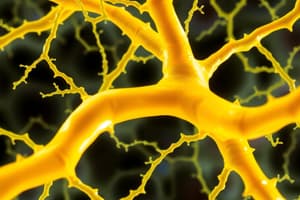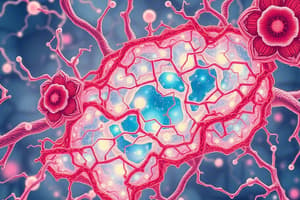Podcast
Questions and Answers
Which component of the extracellular matrix provides strength?
Which component of the extracellular matrix provides strength?
- Collagen (correct)
- Elastin
- Glycoproteins
- Proteoglycans
What is one primary function of connective tissue?
What is one primary function of connective tissue?
- Producing hormones
- Facilitating gas exchange
- Transporting nutrients (correct)
- Generating electrical impulses
Which type of connective tissue is characterized by tightly packed fibers?
Which type of connective tissue is characterized by tightly packed fibers?
- Reticular Connective Tissue
- Loose Connective Tissue
- Specialized Connective Tissue
- Dense Connective Tissue (correct)
Mesenchyme is differentiated into which of the following cell types?
Mesenchyme is differentiated into which of the following cell types?
Which of the following is a characteristic of rheumatoid arthritis?
Which of the following is a characteristic of rheumatoid arthritis?
What role do proteoglycans play in the extracellular matrix?
What role do proteoglycans play in the extracellular matrix?
What type of connective tissue primarily stores minerals?
What type of connective tissue primarily stores minerals?
What is Marfan syndrome primarily associated with?
What is Marfan syndrome primarily associated with?
Flashcards are hidden until you start studying
Study Notes
Extracellular Matrix Composition
- Components:
- Fibers: Collagen (strength), elastin (stretch), reticular fibers (support).
- Ground Substance: Amorphous gel-like material; consists of proteoglycans, glycoproteins, and water.
- Function: Provides structural support and regulates communication between cells.
Functions Of Connective Tissue
- Support: Provides structural framework for organs and tissues.
- Protection: Cushions and protects organs (e.g., bone, cartilage).
- Transport: Blood transports nutrients, gases, and waste.
- Storage: Adipose tissue stores energy; bone stores minerals.
- Immune Response: Connective tissues contain cells like macrophages that respond to pathogens.
Types Of Connective Tissue
-
Loose Connective Tissue:
- Provides elasticity and support.
- Example: Areolar tissue.
-
Dense Connective Tissue:
- Composed of tightly packed fibers.
- Example: Tendons and ligaments.
-
Specialized Connective Tissue:
- Includes blood, bone, cartilage, and adipose tissue.
- Each type has unique functions (e.g., blood for transport, cartilage for cushioning).
Development Of Connective Tissue
- Origin: Derived from mesoderm during embryonic development.
- Mesenchyme: A type of undifferentiated connective tissue that can develop into various connective tissues.
- Differentiation: Mesenchymal cells differentiate into specific cell types (e.g., fibroblasts, chondrocytes).
Connective Tissue Diseases
- Overview: Disorders affecting connective tissues can lead to various health issues.
- Examples:
- Rheumatoid Arthritis: Autoimmune disorder attacking cartilage and synovial membranes.
- Lupus Erythematosus: Autoimmune disease affecting multiple connective tissues.
- Marfan Syndrome: Genetic disorder affecting connective tissue structure, leading to cardiovascular and skeletal issues.
- Ehlers-Danlos Syndrome: Group of disorders affecting collagen synthesis, leading to hyper-flexibility and skin elasticity.
Extracellular Matrix Composition
- Components:
- Fibers include collagen for strength, elastin for stretchability, and reticular fibers for support.
- Ground substance consists of a gel-like matrix made up of proteoglycans, glycoproteins, and water.
- Function:
- Provides structural support for tissues and regulates cell communication.
Functions Of Connective Tissue
- Support:
- Forms the structural framework for various organs and body tissues.
- Protection:
- Cushions and shields organs; for example, bones protect vital organs and cartilage reduces friction.
- Transport:
- Blood serves as a transport medium for nutrients, oxygen, carbon dioxide, and waste products.
- Storage:
- Adipose tissue stores energy, while bone tissue functions as a reservoir for minerals.
- Immune Response:
- Contains immune cells like macrophages that play a crucial role in responding to pathogens.
Types Of Connective Tissue
- Loose Connective Tissue:
- Provides elasticity and support; an example includes areolar tissue, which acts as a cushion.
- Dense Connective Tissue:
- Characterized by tightly packed collagen fibers; includes tendons that connect muscles to bones and ligaments that connect bones to each other.
- Specialized Connective Tissue:
- Comprises blood, bone, cartilage, and adipose tissue; each type performs unique functions, such as blood for nutrient transport or cartilage for shock absorption.
Development Of Connective Tissue
- Origin:
- Connective tissue originates from mesoderm during embryonic development.
- Mesenchyme:
- A form of undifferentiated connective tissue capable of evolving into diverse types of connective tissues.
- Differentiation:
- Mesenchymal cells undergo differentiation to transform into specialized cells like fibroblasts and chondrocytes.
Connective Tissue Diseases
- Overview:
- Disorders affecting connective tissues can lead to significant health complications.
- Rheumatoid Arthritis:
- An autoimmune disorder that primarily targets cartilage and synovial membranes, causing inflammation.
- Lupus Erythematosus:
- A systemic autoimmune disease that impacts multiple connective tissues and organs.
- Marfan Syndrome:
- A genetic disorder that disrupts normal connective tissue structure, potentially leading to cardiovascular and musculoskeletal problems.
- Ehlers-Danlos Syndrome:
- A group of conditions that affect collagen synthesis, resulting in increased hyper-flexibility and skin fragility.
Studying That Suits You
Use AI to generate personalized quizzes and flashcards to suit your learning preferences.




